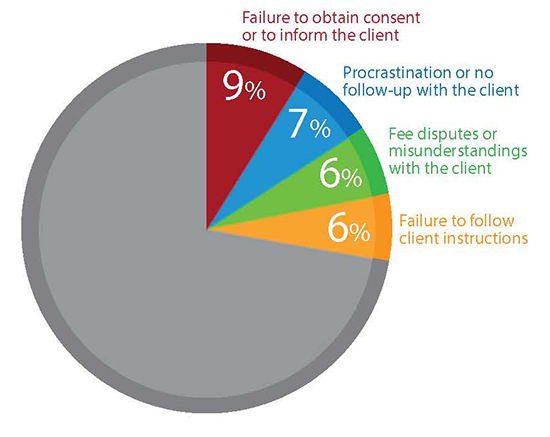
“What we’ve got here is a failure to communicate.” – Cool Hand Luke, 1967
The prison warden, portrayed masterfully by Strother Martin, wasn’t talking about lawyer-client communications, of course. He was busy dealing with Paul Newman’s character in that classic movie.
Claims involving communication issues are generally avoidable, yet at Wisconsin Lawyers Mutual Insurance Co. (WILMIC), client communication mistakes also are among the most frequently cited by people filing malpractice claims. Lack of communication is also traditionally high on the list of the most frequent complaints among grievances filed with the Office of Lawyer Regulation (OLR), according to one of the agency’s annual reports.
Even with all the instant communication devices at our fingertips (smartphones, tablets, laptops, and so on), many people still think lawyers don’t communicate very well. In a Gallup poll conducted several years ago, a whopping 80 percent of respondents said lawyers should do a better job of communicating with their clients.
Before cell phones were prevalent, communication was less immediate. Now with all this technology, often lawyers unintentionally might give clients expectations of instant and constant availability.
Doug Swanson, a lawyer with Habush Habush and Rottier in Waukesha, says, “I try to be as consistent as possible when explaining how the process of bringing a personal injury claim typically works.”
Swanson says that clients can be overwhelmed by the various changes in their daily life as a result of being injured, especially soon after they’ve hired a lawyer. “Providing a roadmap as to what the process will typically involve helps set proper expectations as to the time involved in pursuing a claim. If clients have an understanding from the outset of their claim as to what to expect, I find that the communication issues with the client are typically positive.”
Bill Williams, with Bell Moore & Richter, Madison, does estate planning work. He says managing the many electronic communications options with clients is something every lawyer must consider. “A challenge in estate planning is explaining complex concepts concisely but thoroughly. Sometimes email responses are just not the best way for a client to process what you are trying to tell them. And, just like a law school exam, answer the question that is asked, not the one you want to respond to.”
Every time a lawyer is unresponsive to a client’s phone message or doesn’t fully explain a case, the image of the profession is harmed. What’s worse is that those incidents sometimes lead to malpractice claims or OLR grievances.
Unhappy clients or uninformed clients are more likely to have some complaints about their case, and probably about their lawyer, too.
Why are some clients unhappy with the way they are getting, or not getting, information from their lawyer? Matt Beier, claims attorney at WILMIC, says lawyers and clients sometimes speak to each other on very different levels. “Clients often don’t understand the legal language and issues their lawyers are explaining to them. Unfortunately, they often don’t ask for more information. Lawyers often think just telling a client is enough, when, in fact, it isn’t. Anything that is important in a representation is best confirmed in writing with the client, after the discussion, so the client can review it when there is time and some space to consider everything they have been told about their case.”
Types of Communication Errors Made

Communication mistakes account for more than 25 percent of the claims that WILMIC handles. Here is the breakdown.
Communication in the Digital Age
The digital age has changed the way lawyers practice law and also has changed clients’ expectations. Today, many clients have internet access at home or on their smartphones. That has raised the bar for lawyers when it comes to response time. Because of the speed and ease of use of electronic technology, clients can constantly fire off emails and often expect responses almost as quickly. But, Beier cautions, the rapidity of a response does not necessarily mean it is effective communication. “It often takes some time to research and think before opining on a matter. Advice should not be off the cuff.”
An ABA survey a couple years ago showed that 58 percent of all lawyers texted their clients “regularly” or “occasionally.” Beier says technology continues to move the standards for lawyer-client communication. “It is often easier to respond today – that’s a good thing. But sometimes those responses are [made] without thinking through the issues – that is not a good thing. Lawyers need to educate clients about what expectation is reasonable to allow them to do the work they are retained to do. Lawyers need to exercise restraint when using email and other electronic communications. Lawyers should not feel like they must respond right away to every email.”
Williams says, “Email has completely changed the landscape since I started practicing in 1985. Aside from not seeing or even hearing a client communicate with you, email triggers an urge to respond immediately and briefly. Often this is not even an appropriate way to communicate about estate planning. On the other hand, for simple questions that don’t require nuanced communication, email can expedite the planning process by preventing easily answered questions from holding up the client’s planning decisions.”
The worst thing an attorney can do is be perceived as noncaring by a client who is experiencing a difficult emotional time.
Swanson agrees. “Many clients, especially younger clients, rely on email as their favorite method of communication. I explain at our initial meeting that some questions will require personal details that are best discussed over the phone or in person. However, there are appropriate uses of technology to help confirm appointments or address details that are not as personal in nature.
“I encourage clients to contact me at any time and in any method that they feel comfortable with. However, I explain to them that I will likely respond to any emailed question with a telephone call. When it is difficult to coordinate schedules, I will respond with an email asking the client to let me know when an appropriate time would be for me to call. I also explain to clients that many times, having ‘just a quick question’ does not mean that there will be a corresponding quick answer. In order to fully communicate with a client, I believe it is necessary to have a verbal communication of some type so that the entire topic that is on the client’s mind can be addressed.”
Williams also still values face-to-face meetings. “You can’t see emotion in email or detect sarcasm. A phone call can be better, but there is no substitute for being able to read facial expressions and body language. I listen better to a person sitting across the table from me than I do someone on the phone or who’s communicating by email.”
Swanson agrees. “I believe face-to-face meetings are invaluable. While there are some questions or conversations that can be addressed over the telephone, sitting across the table from a client to address status or answer questions instills confidence and a better understanding of the process that takes place in order to resolve a client’s claims. Often, communication in writing or over the phone does not convey a message adequately. In fact, written words often seem harsh or can be misinterpreted as being negative.
“However, when a meeting takes place in person, an individual’s intonation and facial expressions allow each person to much more accurately understand what is actually being said. It also allows the attorney to respond to a client’s questions or concerns in a much more caring and sympathetic manner.”
It is never premature to have questions. However, it is often premature to have answers.
Of course, following up in writing is crucial as well. Beier adds, “Lawyers are expected to write things down. If something isn’t in writing, the door is wide open to complaints and misunderstandings. In some cases, the misunderstandings are that the case didn’t turn out as the client wanted: if that was a possibility, it should be something discussed and documented beforehand. Lawyers should have notes in their files, too. Contemporaneous notes are often the best source to determine what was discussed.”
Communication mistakes account for more than 25 percent of the claims that WILMIC handles. Many of them are avoidable.
According to Swanson, “The emotional impact on a client when dealing with personal injury claims is probably the largest factor in communication between the attorney and client. It may be very difficult for a client to understand the details of any claim as a result of being upset, angry, or experiencing grief as a result of the loss. It is incumbent upon the attorney to patiently work through these concerns with the client so that a full understanding of the issues can be obtained. The worst thing an attorney can do is be perceived as noncaring by a client who is experiencing a difficult emotional time.”
Common Pitfalls
Establishing communication rules and expectations from the beginning can help avoid problems down the road. “Failing to do that sometimes leads to a malpractice claim,” says Beier.
Swanson says one of the best ways to avoid a breakdown in communication is to address a client’s expectations regarding communications from the outset. “I explain in every initial meeting with a client that it is never premature to have questions. However, it is often premature to have answers. It is very important to explain why there may not be an applicable answer at that time.”
Good communication doesn’t depend on what you say to your client. It’s based on what the client hears. Talk in a way your clients will understand.
“It’s also important to remember that the same question is likely going to be asked on multiple occasions. Clients typically do not understand why it takes so long for their cases to be resolved. Some clients will be more persistent than others. The worst thing an attorney can do is fail to respond to messages left by a client in a timely manner. When a client leaves a message for me while I am unavailable, I attempt to return that call on the same day.”
Conclusion
I say it often at WILMIC’s risk management seminars. The world has changed from the days when clients had blind faith in what their lawyers were telling them. Clients today are more likely to be educated, especially with self-help internet sites and other electronic information available to them at the click of a mouse or the touch of a smartphone screen. Today, they are more likely to want to be actively involved in their case and understand the process. And they have higher expectations, not only regarding the information they will receive, but also how quickly they get it and their overall customer service experience.
Good communication doesn’t depend on what you say to your client. It’s based on what the client hears. Talk in a way your clients will understand. And, Williams adds, “Use engagement letters and concluding letters. Tell your client what you hope to accomplish at the outset. At the end, recite what was done, or not done, and whether there is anything left to do. And of course, document your communications.”
So, resolve to communicate well with your clients. Be responsive, follow up with clients when necessary, clearly identify your expectations as well as those of your clients, document your communication with your clients, and above all, speak in a language clients understand. Understanding why something is the way it is makes it easier to accept and rationalize rather than just being told “that’s the way it is.”
